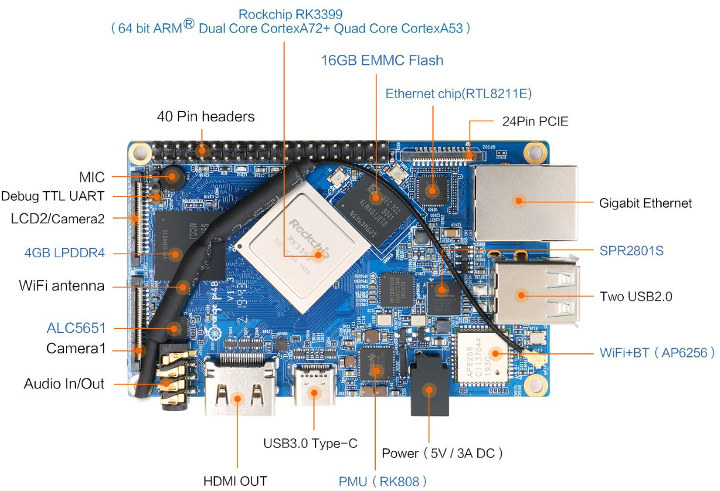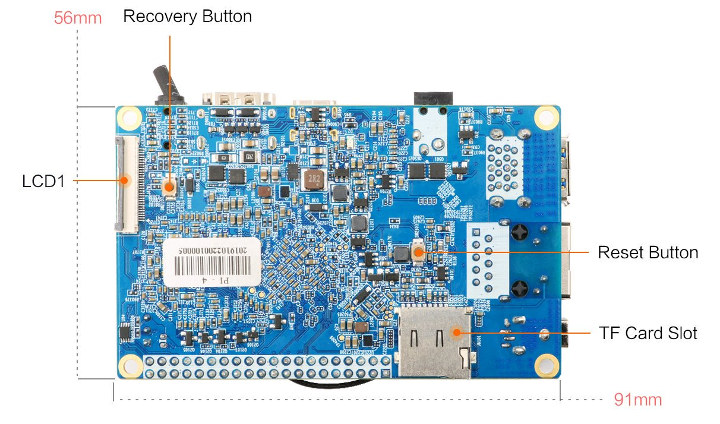Orange Pi 4 is yet another Rockchip RK3399 SBC with 4GB RAM, while Orange Pi 4B adds Gyrfalcon Lightspeeur 2801A AI Accelerator. Both models were announced about 10 days but were not for sale just yet.
The company has now launched the board on both Aliexpress and their newly opened Amazon store with three options:
- Orange Pi 4 with no eMMC flash – $49.90
- Orange Pi 4 with 16GB eMMC flash – $59.90
- Orange Pi 4B with 16GB eMMC flash, Gyrfalcon NPU – $69.90

Quick reminder of Orange Pi 4/4B specifications:
- SoC – Rockchip K3399 hexa-core big.LITTLE processor with two Arm Cortex A72 cores, four Cortex A53 cores, and an ARM Mali-T860 MP4 GPU with support for OpenGL ES 1.1 to 3.1 support, OpenVG1.1, OpenCL and DX 11
- System Memory – 4 GB LPDDR4
- Storage – Optional 16 GB eMMC flash, micro SD card
- NPU (Orange Pi 4B only) – Gyrfalcon Lightspeeur SPR2801S NPU delivering up to 2.8TOPS @ 300mW, 5.6 TOPS @ 100 MHz (peak performance)
- Video Output/Display Interface
- HDMI 2.0 up to 4K @ 60 Hz
- LCD connector for MIPI DSI display
- USB-C port with DisplayPort Alternate mode
- Video Decode – 4K VP9 and 10-bit H.265 video codec support up to 60 fps
- Audio – 3.5mm audio jack for headphones; HDMI digital audio output; built-in microphone; ALC5651 codec
- Connectivity – Gigabit Ethernet port (via RTL8211E transceiver), dual-band 802.11ac 2×2 MIMO WiFi and Bluetooth 5.0 (Ampak AP6256 module)
- USB
- Orange Pi 4 – 1x USB 3.0 port, 2x USB 2.0 host ports, 1x USB 3.0 type C port
- Orange Pi 4B – 2x USB 2.0 host ports, 1x USB 3.0 type C port
- Camera – 2x camera headers
- Debugging – 3-pin serial header
- Expansion
- 40-pin GPIO 2.54mm pitch female header with 2x I2C, 1x SPI/UART, 8x GPIO, etc…
- 24-pin connector for PCIe signals
- Power Supply
- 5V/3A via DC jack
- 5V via type C port
- RK808 PMU
- Dimensions – 91 x 56 mm

The company will provide Android 8.1, Ubuntu 16.04/18.04, and Debian 9 for the board, but at the time of writing the information has yet to be posted on their Download page. Gyrfalcon Lightspeeur SPR2801S NPU on Orange Pi 4B should be using the same SDK as Orange Pi AI Stick Lite USB neural compute stick since it’s connected to one of Rockchip RK3399 processor’s USB 3.0 interfaces.
The price of Orange Pi 4B is really impressive, as last year you’d have to pay about the same price just with the USB stick. Orange Pi 4 is also good value as at $49.90 it’s the cheapest Rockchip RK3399 board with 4GB RAM. For comparison, FriendlyELEC NanoPi M4 is also $50 but with only 2GB RAM, while Pine64 RockPro64 starts at $59.99 with 2GB RAM. Both are available with 4GB but at around $80.

Jean-Luc started CNX Software in 2010 as a part-time endeavor, before quitting his job as a software engineering manager, and starting to write daily news, and reviews full time later in 2011.
Support CNX Software! Donate via cryptocurrencies, become a Patron on Patreon, or purchase goods on Amazon or Aliexpress. We also use affiliate links in articles to earn commissions if you make a purchase after clicking on those links.





Can one use eDP LCD panel with this board? Is RockPro64 only RK3399 board with eDP and PCIe available?
There are others with eDP: https://www.cnx-software.com/?s=RK3399+eDP
They usually expose PCIe signals as well but either through headers or an mPCIe socket. I can’t think of any other boards with an actual PCIe socket.
> I can’t think of any other boards with an actual PCIe socket.
The ‘ROCK960 Enterprise Edition’ comes to my mind: https://www.cnx-software.com/2018/03/19/96boards-unveils-a-i-developer-platforms-hikey-970-ultra96-rock960-pro-enterprise-edition/
Though no idea whether it has been discontinued already. And the PCIe slot’s positions is rather silly (caused by 96boards ‘Enterprise’ specifications).
@tkaiser
Ficus is cancelled due to the lack of BMC development. Instead, the ficsu2 changes the pcie x16 to pcie x4 for the alignment with pcie cards…
https://www.96rocks.com/blog/2019/09/11/introduce-vamrc-rk3399pro-som-and-ficus2-carrier-board/
And who should buy Ficus2 now that RockPi N10 using the same SoM is announced?
FIcus2 is a full feature evaluation board for the VMARC SoM, commercial/industrial customer will buy it.
Is there any hat/cape/accessory for the pcie header available?
Wait, Mali does not support OpenGL but OpenGL ES. Also real DirectX is not in there. Graphical drivers are quite different since the architecture isn’t the same, and also Microsoft does not provide a shit about their graphical libraries to other systems. The only ARM boards I recall are fully compatible with OpenGL are Tegras because Nvidia is involved on it, but I don’t know what’s the status of that right now. I always wanted to have one Tegra for tests but they are usually quite expensive for my pocket 🙁
Jetson Nano is $100.
“Two USB 2.0” are using an USB 3 connector ? :thinking:
Is 49$ version sold out?
Just asked them:
Thank you so much for checking upon this! Greetings from Oslo/Norway:)
The $49 version is back in stock.
Buying OrangePi is being an asshole. There is no support, no guarantees of any kind. Neither in forums nor by the manufacturer. Have you taken a look at the forums/support on their website?
RPi4 is for good people. Lots of support and the master visionaire Eben Upton even replies to inquiries as we saw in hackaday https://hackaday.com/2019/12/06/not-quite-so-hot-stuff-a-thermal-exam-on-the-latest-raspberry-pi/#comment-6200927
About Gyrfalcon,,,,
Enter their forums! You can! Register and ohhhh…..You’re not a valid guy! We’re just releasing stock with assholes like you!
See in Youtube for learn!
The PCIe is an illusion, Just….
https://www.youtube.com/watch?v=xQ95XzvJtvs
Hahahahaha!
Orange Pi 4/B firmware image and tools have now been upload to Orange Pi download/resources page.
Nice board, however for my purpose a bit expensive. Nanopi3 Fire has same cpu performance and gigabit network as well. Even other spec and software support are lower, it is for $35.
Everything with the RK3399 seems expensive. It feels to me as if they have frittered away a several-year lead by pricing themselves out of the mass market.
But then I also think that a great opportunity was lost by not making it a first class target for mainline Linux distros. It seems to share that with all the Chinese SoCs. Perhaps there are not enough customers to make a mass market. If the Android media boxes could run stock Ubuntu etc., a good portion of the Raspberry Pi market might have been captured.
I think that the main problem is to have put half of the total performance in only two big cores and half of it in 4 small, making it a de-facto specific device SoC. This chip isn’t interesting compared to available competition as a general purpose SoC as the only way to exploit its performance is to use a massively threaded workload, an area which was already well covered by cheaper A53 devices like the NanoPI Fire3. And single-thread performance is good only on the A72 cores, which represent only half of the device’s capacity, possibly making less equipped alternatives more attractive.
I think the A311D will not suffer from this design mistake because it can easily delegate the two A53 to low performance tasks, control, etc and have 4 big ones for high-performance processing. Typically in a build farm you’d run distccd and its compression on the A53 and gcc on the A73. You cannot do that on the RK3399 (well you can but then you cut the performance in half).
Then the RK3399 makes sense in set-top-boxes and such devices where you have mainly a big task (browser, video player etc) and lots of small stuff. But quite frankly they could have dropped two A53 cores and nobody would have even noticed.
Willy, you looked at recent NanoPi NEO Plus2 V2.0 ?
Just a little bit (schematics and description), as I already have the V1.0 and wanted to understand the difference with v2. The main difference seems to be that the RAM is now 32-bit instead of 16-bit previously. They also changed the micro-SD connector to save some room for the extra DDR chip so the card will stand out, so it becomes clear that you’re supposed to use the eMMC for regular operations. I do like the plus2, it has all I need, except that when you connect the OLED display on it there’s no more enclosure available. That’s where the neo2-black becomes interesting, as you can have everything the plus2 has except wifi, but you have the display.